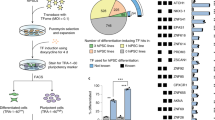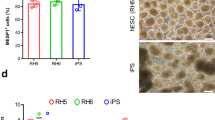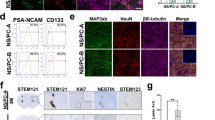Abstract
Human pluripotent stem cell (hPSC)-derived neural crest (NC) cells present a valuable tool for modeling aspects of human NC development, including cell fate specification, multipotency and cell migration. hPSC-derived NC cells are also suitable for modeling human disease and as a renewable cell source for applications in regenerative medicine. Here we provide protocols for the step-wise differentiation of human embryonic stem cells (hESCs) or human induced pluripotent stem cells (hiPSCs) into neuroectodermal and NC cells using either the MS5 coculture system or a novel defined culture method based on pharmacological inhibition of bone morphogenetic protein and transforming growth factor-β signaling pathways. Furthermore, we present protocols for the purification and propagation of hPSC-NC cells using flow cytometry and defined in vitro culture conditions. Our protocol has been validated in multiple independent hESC and hiPSC lines. The average time required for generating purified hPSC-NC precursors using this protocol is 2–5 weeks.
This is a preview of subscription content, access via your institution
Access options
Subscribe to this journal
Receive 12 print issues and online access
$259.00 per year
only $21.58 per issue
Buy this article
- Purchase on Springer Link
- Instant access to full article PDF
Prices may be subject to local taxes which are calculated during checkout













Similar content being viewed by others
References
Thomson, J.A. et al. Embryonic stem cell lines derived from human blastocysts. Science 282, 1145–1147 (1998).
Perrier, A.L. et al. Derivation of midbrain dopamine neurons from human embryonic stem cells. Proc. Natl. Acad. Sci. USA 101, 12543–12548 (2004).
Li, X.J. et al. Specification of motoneurons from human embryonic stem cells. Nat. Biotechnol. 23, 215–221 (2005).
Roy, N.S. et al. Functional engraftment of human ES cell-derived dopaminergic neurons enriched by coculture with telomerase-immortalized midbrain astrocytes. Nat. Med. 12, 1259–1268 (2006).
Lee, H. et al. Directed differentiation and transplantation of human embryonic stem cell derived motoneurons. Stem Cells 25, 1931–1939 (2007).
Lee, G. et al. Isolation and directed differentiation of neural crest stem cells derived from human embryonic stem cells. Nat. Biotechnol. 25, 1468–1475 (2007).
Pruszak, J., Sonntag, K.C., Aung, M.H., Sanchez-Pernaute, R. & Isacson, O. Markers and methods for cell sorting of human embryonic stem cell-derived neural cell populations. Stem Cells 25, 2257–2268 (2007).
Elkabetz, Y. et al. Human ES cell-derived neural rosettes reveal a functionally distinct early neural stem cell stage. Genes. Dev. 22, 152–165 (2008).
Chambers, S.M. et al. Highly efficient neural conversion of human ES and iPS cells by dual inhibition of SMAD signaling. Nat. Biotechnol. 27, 275–280 (2009).
Fuchs, S. & Sommer, L. The neural crest: understanding stem cell function in development and disease. Neurodegener. Dis. 4, 6–12 (2007).
Slaugenhaupt, S.A. et al. Tissue-specific expression of a splicing mutation in the IKBKAP gene causes familial dysautonomia. Am. J. Hum. Genet. 68, 598–605 (2001).
Farlie, P.G., McKeown, S.J. & Newgreen, D.F. The neural crest: basic biology and clinical relationships in the craniofacial and enteric nervous systems. Birth Defects Res. C Embryo Today 72, 173–189 (2004).
Wurdak, H., Ittner, L.M. & Sommer, L. DiGeorge syndrome and pharyngeal apparatus development. Bioessays 28, 1078–1086 (2006).
Etchevers, H.C., Amiel, J. & Lyonnet, S. Molecular bases of human neurocristopathies. Adv. Exp. Med. Biol. 589, 213–234 (2006).
Ross, R.A. & Spengler, B.A. Human neuroblastoma stem cells. Semin. Cancer. Biol. 17, 241–247 (2007).
Carniti, C. et al. The Ret(C620R) mutation affects renal and enteric development in a mouse model of Hirschsprung's disease. Am. J. Pathol. 168, 1262–1275 (2006).
Hims, M.M. et al. A humanized IKBKAP transgenic mouse models a tissue-specific human splicing defect. Genomics 90, 389–396 (2007).
Selleck, M.A. & Bronner-Fraser, M. The genesis of avian neural crest cells: a classic embryonic induction. Proc. Natl. Acad. Sci. USA 93, 9352–9357 (1996).
Crane, J.F. & Trainor, P.A. Neural crest stem and progenitor cells. Annu. Rev. Cell. Dev. Biol. 22, 267–286 (2006).
Dupin, E., Real, C. & Ledouarin, N. The neural crest stem cells: control of neural crest cell fate and plasticity by endothelin-3. An. Acad. Bras. Cienc. 73, 533–545 (2001).
Anderson, D.J. Genes, lineages and the neural crest: a speculative review. Philos. Trans. R. Soc. Lond. B. Biol. Sci. 355, 953–964 (2000).
Wong, C.E. et al. Neural crest-derived cells with stem cell features can be traced back to multiple lineages in the adult skin. J. Cell. Biol. 175, 1005–1015 (2006).
Creuzet, S., Couly, G. & Le Douarin, N.M. Patterning the neural crest derivatives during development of the vertebrate head: insights from avian studies. J. Anat. 207, 447–459 (2005).
Kruger, G.M. et al. Neural crest stem cells persist in the adult gut but undergo changes in self-renewal, neuronal subtype potential, and factor responsiveness. Neuron. 35, 657–669 (2002).
Motohashi, T., Aoki, H., Chiba, K., Yoshimura, N. & Kunisada, T. Multipotent cell fate of neural crest-like cells derived from embryonic stem cells. Stem Cells 25, 402–410 (2007).
Buchstaller, J. et al. Efficient isolation and gene expression profiling of small numbers of neural crest stem cells and developing Schwann cells. J. Neurosci. 24, 2357–2365 (2004).
Morrison, S.J., White, P.M., Zock, C. & Anderson, D.J. Prospective identification, isolation by flow cytometry, and in vivo self-renewal of multipotent mammalian neural crest stem cells. Cell 96, 737–749 (1999).
Sauka-Spengler, T., Meulemans, D., Jones, M. & Bronner-Fraser, M. Ancient evolutionary origin of the neural crest gene regulatory network. Dev. Cell 13, 405–420 (2007).
Holland, L.Z. & Holland, N.D. Evolution of neural crest and placodes: amphioxus as a model for the ancestral vertebrate? J. Anat. 199, 85–98 (2001).
Jiang, X. et al. Isolation and characterization of neural crest stem cells derived from in vitro-differentiated human embryonic stem cells. Stem. Cells. Dev. 18, 1059–1070 (2008).
Zhou, Y. & Snead, M.L. Derivation of cranial neural crest-like cells from human embryonic stem cells. Biochem. Biophys. Res. Commun. 376, 542–547 (2008).
Papapetrou, E.P. et al. Stoichiometric and temporal requirements of Oct4, Sox2, Klf4, and c-Myc expression for efficient human iPSC induction and differentiation. Proc. Natl. Acad. Sci. USA 106, 12759–12764 (2009).
Lee, G. et al. Modeling pathogenesis and treatment of familial dysautonomia using patient specific iPS cells. Nature 461, 402–406 (2009).
Nishikawa, S., Goldstein, R.A. & Nierras, C.R. The promise of human induced pluripotent stem cells for research and therapy. Nat. Rev. Mol. Cell. Biol. 9, 725–729 (2008).
Billon, N. et al. The generation of adipocytes by the neural crest. Development 134, 2283–2292 (2007).
Sandell, L.L. & Trainor, P.A. Neural crest cell plasticity. Size matters. Adv. Exp. Med. Biol 589, 78–95 (2006).
Barberi, T., Willis, L.M., Socci, N.D. & Studer, L. Derivation of multipotent mesenchymal precursors from human embryonic stem cells. PLoS Med. 2, e161 (2005).
Etchevers, H.C., Vincent, C., Le Douarin, N.M. & Couly, G.F. The cephalic neural crest provides pericytes and smooth muscle cells to all blood vessels of the face and forebrain. Development 128, 1059–1068 (2001).
Noden, D.M. & Trainor, P.A. Relations and interactions between cranial mesoderm and neural crest populations. J. Anat. 207, 575–601 (2005).
Placantonakis, D.G. et al. BAC transgenesis in human embryonic stem cells as a novel tool to define the human neural lineage. Stem Cells 27, 521–532 (2009).
Anderson, D.J. Cellular and molecular biology of neural crest cell lineage determination. Trends Genet. 13, 276–280 (1997).
Acknowledgements
We thank all the members of Studer, Tabar and Tomishima labs for technical advice and helpful discussions on the protocol. Our work was supported by grants from the Starr Foundation, NYSTEM and NINDS. Additional support was provided by the New York Stem Cell Foundation (NYCSF, Druckenmiller fellowships to G.L.) and by the Starr Scholar fellowship to S.M.C.
Author information
Authors and Affiliations
Contributions
All authors contributed to the development of the method and the writing of the manuscript.
Corresponding author
Rights and permissions
About this article
Cite this article
Lee, G., Chambers, S., Tomishima, M. et al. Derivation of neural crest cells from human pluripotent stem cells. Nat Protoc 5, 688–701 (2010). https://doi.org/10.1038/nprot.2010.35
Published:
Issue Date:
DOI: https://doi.org/10.1038/nprot.2010.35
This article is cited by
-
Transcriptomics of Hirschsprung disease patient-derived enteric neural crest cells reveals a role for oxidative phosphorylation
Nature Communications (2023)
-
“Cutting the Mustard” with Induced Pluripotent Stem Cells: An Overview and Applications in Healthcare Paradigm
Stem Cell Reviews and Reports (2022)
-
Modelling skeletal pain harnessing tissue engineering
In vitro models (2022)
-
Towards bridging the translational gap by improved modeling of human nociception in health and disease
Pflügers Archiv - European Journal of Physiology (2022)
-
Glycan Epitope and Integrin Expression Dynamics Characterize Neural Crest Epithelial-to-Mesenchymal Transition (EMT) in Human Pluripotent Stem Cell Differentiation
Stem Cell Reviews and Reports (2022)
Comments
By submitting a comment you agree to abide by our Terms and Community Guidelines. If you find something abusive or that does not comply with our terms or guidelines please flag it as inappropriate.



